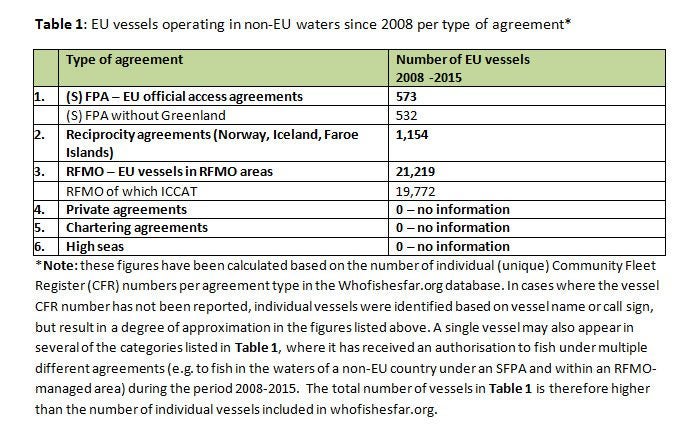June 10, 2016
What explains the 22,085 EU vessels operating in non-EU waters since 2008? Why whofishesfar.org accounts for far more vessels than the EU long distance fleet.
BY: Oceana Web
Topics:
1.- Which EU vessels are included in whofishesfar.org?
Any EU vessel operating in external waters needs to obtain a fishing authorisation from its flag State (the EU member state in which it is registered) in order to do so. Non-EU vessels fishing in EU waters, from flag states such as Iceland, Faroe Islands, Norway, Seychelles and Venezuela also need a fishing authorisation to operate in EU waters. These authorisations are issued under the EU Regulation governing the activities of the EU’s external fishing fleet – currently the 2008 Fishing Authorisation Regulation. This Regulation is in the process of revision, with the proposal for a future external fleet Regulation issued by the European Commission in December 2015 currently being considered by the European Parliament and Council.
Data on any fishing authorisations issued under the external fleet Regulation since 2008 were requested from the European Commission via an access to information request. The data that were provided, which cover the period 2008 to 2015, have been made available to the public on Whofishesfar.org.
Whofishesfar.org includes fishing vessels operating under all types of agreement covered by the external fleet Regulation:
- Sustainable Fisheries Partnership Agreements or (S)FPAs;
- Bilateral agreements for vessels from Venezuela and Seychelles to operate in EU waters (respectively in French Guiana and Mayotte);
- Reciprocity agreements for EU vessels to operate in the waters of Iceland, Norway and Faroe Islands, and vice versa;
- EU vessels fishing in the areas managed by Regional Fisheries Management Organisations (RFMO).
EU vessels may also carry out fishing activities in non-EU waters under three other types of agreement. However, the European Commission did not provide any data on the three types of agreements below and details of vessels fishing under these agreements are therefore not included in Whofishesfar.org.
- EU vessels fishing under private agreements
- EU vessels under chartering agreements
- EU vessels fishing in the high seas

2.- Whofishesfar.org total number of EU vessels fishing in external waters vs. official estimates for the European Long Distance Fleet
The total number of EU vessels that have fished in external waters since 2008 – the 22,085 vessels included in Whofishesfar.org – is much higher than accepted figures for the size of the EU’s Long Distance Fleet. There are two publicly available estimates of the European Long Distance Fleet. The first is provided in a study from 2008 that identified 718 vessels for the year 2007. This study looked only at vessels that operated for more than 90% of the time outside EU waters. The second is provided in the 2014 Annual Economic Report on the European Fishing Fleet and places the figure at 335 vessels. This study defines the distant water fleet as all EU-registered vessels over 24 metres operating in the outermost regions or non-EU waters outside the North Atlantic, Mediterranean and Black Sea.
However, as mentioned above, Whofishesfar.org also includes vessels that are not considered to be part of the European Long Distance fleet. This primarily concerns the majority of the EU vessels under the reciprocity agreements with Faroe Islands, Iceland and Norway as well as vessels operating in the Mediterranean and Black Sea, under the RFMOs in that area – the International Commission for the Conservation of Atlantic Tunas (ICCAT) and the General Fisheries Commission for the Mediterranean and Black Sea (GFCM). Some of these vessels might fish in non-EU waters for limited periods of time or have requested an authorisation to operate in non-EU waters but do not actually use this authorisation.
The total number of vessels included in whofishesfar.org is therefore larger than the number of vessels that are considered to belong to the European Long Distance Fleet.
3.- EU vessels operating under private, chartering agreements or fishing on the high seas are not included in whofishesfar.org
Given the lack of information on EU vessels fishing under private agreements, under chartering agreements or on the high seas (as explained under Section 1 above) the total number of EU vessels operating in non-EU waters could be even higher than 22,085.
4.- The issue with the EU vessel numbers for ICCAT
As shown in Table 1, between 2008 and 2015 a total of 19,772 individual EU vessels were authorised to fish in the ICCAT area. Of this 19,772, almost half (9,988) were Italian-flagged vessels. In March 2016, the Italian government adjusted the number of Italian vessels targeting swordfish in the ICCAT area, bringing it down from over 8,400 vessels in 2015 to 849 vessels. The current review of the external fleet Regulation provides member states with a crucial opportunity to ensure that vessels authorised to fish in RFMO areas are actually active or operating in these areas. Accurate information on where vessels are fishing and which species they are targeting is vital to ensuring transparency and accountability in global fisheries, and the sustainable management of fish stocks.
1.- Proposal for Regulation of the European Parliament and of the Council on the sustainable management of external fishing fleets (COM/2015/636) and Council Regulation (EC) No 1006/2008 concerning authorisations for fishing activities of Community fishing vessels outside Community waters and the access of third country vessels to Community waters
2.- Study on the European External Fleet Contract FISH/2006/02 Final Report, January 2008
3.- The 2014 Annual Economic Report on the EU Fishing Fleet (STECF 14-16) Scientific, Technical and Economic Committee for Fisheries (STECF)
4.- Decreto Direttoriale n. 3992 del 29 febbraio 2016 https://www.politicheagricole.it/flex/cm/pages/ServeBLOB.php/L/IT/IDPagina/9817

